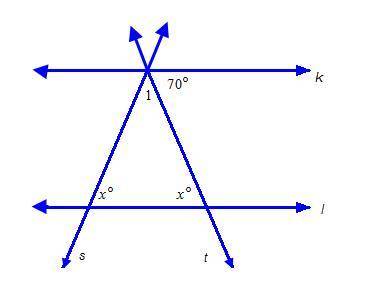
Mathematics, 10.06.2020 04:57 Kookiexperfect9420
Lines k and l are parallel. When lines k and l are cut by the transversals below, an isosceles triangle is formed. Lines k and l are parallel. Lines s and t intersect lines k and l to form a triangle. At the intersection of lines s, t, and k, clockwise from top left, the angles are blank, blank, blank, 70 degrees, 1, blank. At the intersection of lines s and l, the angles are blank, x degrees, blank, blank. At the intersection of lines l and t, the angles are x degrees, blank, blank, blank. What is Measure of angle 1? 35 degrees 40 degrees 55 degrees 70 degrees


Answers: 3


Another question on Mathematics

Mathematics, 20.06.2019 18:04
The functions q and r are defined as follows. q(x)= -2x+2 r(x)= x^2 - 1 find the value of r(q(
Answers: 1

Mathematics, 21.06.2019 13:00
Solve the problem by making up an equation. a child is 12 years old, and his father is 32 years older. in how many years will the age of the father be 3 times the age of the child?
Answers: 1

Mathematics, 21.06.2019 13:00
The graph shows the prices of different numbers of bushels of corn at a store in the current year. the table shows the prices of different numbers of bushels of corn at the same store in the previous year. previous year number of bushels price of corn (dollars) 2 10 4 20 6 30 8 40 part a: describe in words how you can find the rate of change of a bushel of corn in the current year, and find the value. part b: how many dollars more is the price of a bushel of corn in the current year than the price of a bushel of corn in the previous year? show your work.
Answers: 1

Mathematics, 21.06.2019 15:00
Find three consecutive numbers such that the sum of one-fourth the first and one-fifth the second is five less than one-seventh the third
Answers: 1
You know the right answer?
Lines k and l are parallel. When lines k and l are cut by the transversals below, an isosceles trian...
Questions


Mathematics, 30.07.2019 22:00

History, 30.07.2019 22:00


Mathematics, 30.07.2019 22:00







English, 30.07.2019 22:00



History, 30.07.2019 22:00



Mathematics, 30.07.2019 22:00




